A feast for all the senses
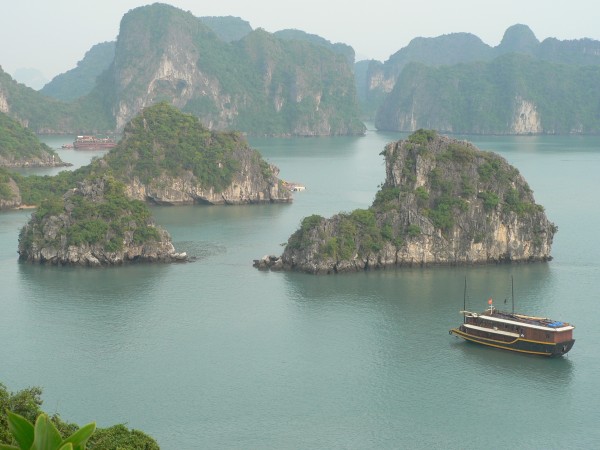
Vietnam has incredible scenic beauty, featuring two main cultivated areas of the Red River Delta in the north and the Mekong Delta in the south. It is made up of equatorial lowlands, high, temperate plateaus and alpine peaks.
Stretching 1600 kilometres along the eastern coast of the Indochinese peninsula, Vietnam is bordered by China to the north and Cambodia and Laos to the west.
Whilst Saigon (also known as Ho Chi Minh City) is the country’s largest population centre, the capital, Hanoi is the political and cultural centre of Vietnam. Haiphong is the Northern region’s main industrial centre and a major sea port, while Da Nang in the Central region, is promoted as the gateway to Indochina. Other major centres include Dalat in the Southern Highlands, renowned for its cool climate and beautiful mountain scenery and Kontum in the Central Highlands.
Vietnam’s population is 84 percent ethnic Vietnamese, two percent ethnic Chinese, with the rest made up of Khmers, Chams and highland Montagnards – over 50 ethnic groups in total. The people speak Vietnamese, with the northern and southern dialects differing slightly from each other, as well as Chinese (both Cantonese and Mandarin), English, French and Russian.
Confucianism, Taoism, Buddhism and Christianity have all served to shape the rich spiritual life of Vietnam, along with the indigenous religion of Caodaism. The main temple for Caodaism is in Tay Ninh town, 90 kilometres north west of Saigon. It offers daily ceremonies and educational tours.
Vietnam is lush and tropical with much jungle and vegetation ranging from the green Mekong Delta to forests containing an estimated 12 000 plant species. The country’s wild fauna is enormously diverse and includes elephants, rhinos, leopards, black bears and a variety of monkeys, birds and reptiles. Saigon’s zoo and botanic gardens are a delightful place for a stroll, as are the tree-lined avenues in Cong Vien Van Hoa Park.
Vietnam’s national parks include: Cat Ba, Ba Be Lake and Cuc Phuong national parks in the north; Bach Ma National Park in the Central region (sponsored by the World Wildlife Fund); and Nam Cat Tien National Park in the south.
In 2003, another national park was opened, becoming the fifth UNESCO recognised site in Vietnam. Phong Nha-Ke Bang national park offers mountains that are ideal for climbing and exploring and it is also home to archaeological and historical relics along with a range of geographic attractions. The most recent to find favour with visitors is the Son Doong (Mountain River) Cave. Discovered in 2009, it is claimed to be the world’s largest cave.
The other four UNESCO recognised sites in Vietnam are Halong Bay, the imperial city of Hué, the ancient quarter of Hoi An and the My Son historical site.
There is a major airport serving each of the three major tourism zones: Saigon serves the Mekong; Da Nang serves Hué, Hoi An and My Son; and Hanoi provides access to Halong Bay and the mountains.
Travel between the three gateway cities is available by air, train and bus. Overnight travel by train or bus is a popular choice for visitors and is inexpensive and relatively comfortable. Chartering a minibus or hiring a car and driver are other viable alternatives. Taxi cabs (some metered, some not) operate in Hanoi, Saigon and most of the major cities. As a rule, it’s best to avoid travelling by car in major cities during peak hour unless you are not in a hurry. Visitors can hire cyclos (pedicabs) to get around, or there is the option to travel the way the locals do and hire a motor scooter.
With a population of 86 million, it is easy to think that all Vietnamese people own a scooter. The roads are full of them. Traffic in the major cities is something that needs to be seen to be believed. Despite the vast numbers though, scooter traffic moves like water. It is constantly flowing, sometimes fast, usually slow and occasionally it will pool due to an obstacle, but then find a way to break through and move on. Walking can prove to be a bit of a challenge, as most footpaths are lined with parked scooters, left there by the locals while they shop or eat.
Vietnam offers the opportunity to sample some truly amazing cuisine. There are said to be nearly 500 traditional dishes, ranging from exotic meats such as bat and cobra, to a variety of fish, vegetables, spices and sauces. As a guide, food in the Central region tends to be spicy, while the Northern region cuisine is mild. The Southern region has an understandable accent on pepper, as Vietnam is the world’s largest producer of the spice.
‘Pho’ is the noodle soup eaten at any time of day and ‘com’ means ‘rice dish’. Because Buddhist monks of the Mahayana tradition are strict vegetarians, many dishes contain tofu, mushrooms and raw, cooked and fermented vegetables. While Vietnamese desserts such as pastry, sticky rice and beans tend to be a little sweet for foreign palates, the selection of local fruits is amazing. Try green dragon fruit, jujube, longan, pomelo, three-seed cherry and water apple. A word of warning, smoking still allowed in most hotels and restaurants in Vietnam, so it’s advisable to get a table outside or by a window.
In Saigon, entertainment can be found at discos and hotel nightclubs, while bars and cafes are popular throughout the rest of the country. For a local experience, enjoy a ‘Beer Hoi’ at a road side bar. It’s cheap, refreshing and a great way to meet the locals.
Vietnam is known for its handicrafts, including lacquer ware, mother-of-pearl inlay, ceramics, bamboo products, jewellery, silk goods, intricately carved statues and paintings. In Hanoi, two popular areas are Hang Gai Street and Hang Bong Street which stock embroidered tablecloths, greeting cards with traditional hand-painted silk covers, water puppets, clothing and antiques. In Saigon, Ben Thanh Market is a good place for shopping. (Vendors will willingly bargain but as a courtesy, do not ask the price of something unless you want to buy it.) Dong Khoi Street is an arts and crafts tourist bazaar.
The currency is the Vietnamese dong. The US dollar acts as a second currency and is readily accepted everywhere. Most gold and jewellery stores will exchange foreign currency and usually have better rates than the hotels. Given the low wages of most of the population, tipping is always greatly appreciated.
Vietnam has three climatic zones with temperatures ranging from 22˚C to 27˚C. In the north, the best time to visit is between October and March. Central Vietnam is protected by the Hai Van Pass Mountains and travelling is recommended year-round. In the south, there are two seasons – dry and rainy. March, April and May are the hottest months. Lightweight clothing is sufficient for the south all year round but warmer clothing is needed during winter (November through April) in the north and in the highlands.
Hanoi is Vietnam’s capital as well as the political, economic and cultural centre of the country. It was chosen as the capital by King Ly Thai To in 1010 when it was renamed Thang Long (the Soaring Dragon) and has remained the capital ever since. In October of 2010, there were major celebrations in the region to celebrate Hanoi’s 1000th year of existence.
Hanoi is home to a landscape of temples, monuments, bustling markets and shaded boulevards. It is a unique fusion of old and new, with beautiful architectural treasures such as the 1500 year old Ambassadors’ Pagoda, the official centre of Buddhism in Hanoi, colonial French homes and modern skyscrapers.
Rich in ancient history, Hanoi preserves almost 600 pagodas, temples and many streets with centuries-old architecture. The city also preserves its poetic features, with rows of trees lining both sides of the streets, parks covering dozens of hectares and natural lakes.
Tourists can visit President Ho Chi Minh’s Mausoleum, Co Loa Castle, the One Pillar Pagoda (which dates back to the 11th century), the Temple of Literature (Van Mieu Quoc Tu Giam – the oldest university in Vietnam), Chua Thay – the Master’s Pagoda, Tay Phuong Pagoda (in Ha Tay Province), Lenin and Thu Le Parks, the Hoan Kiem Lake and the West Lake.
In some of the quiet streets off Hoan Kiem Lake are an increasing number of boutiques and gift/souvenir shops as well as delightful restaurants and cafés that have been artfully established within historic shophouses.
Other attractions include the Museum of History, the Army Museum, the Museum of Revolution, the Museum of Fine Arts and a suburban village where visitors can acquaint themselves with the life of Vietnamese peasants. The Old Quarter of 36 ancient trading streets is a fascinating area to explore, with its bustling trade and tunnel houses.
Just on three hours drive from Hanoi is the world heritage site of Halong Bay. With around 3000 islands rising from the waters of the Gulf of Tonkin, it is an awe-inspiring sight. Some of the most spectacular scenery in Vietnam is in the Tonkin region stretching from the Hoang Lien Mountains (Tonkinese Alps) eastward across the Red River Delta to the islands of Halong Bay.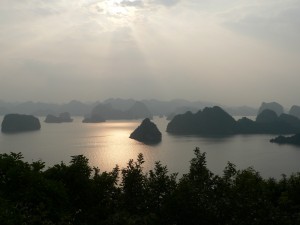
Chinese style junks crisscross their way throughout the 1500 km area, visiting beaches, caves and grottoes that are the work of centuries of wind and rain erosion. Those planning a visit are well advised to take extra memory sticks for the camera as the scenery is some of the most beautiful in the country.
Boat trips are easily arranged at the departure dock and are the ideal way to take in the spectacular islands. An overnight boat trip offers the best value. This allows time for a tour of the huge Sung Sot cave and then the chance to go kayaking at Cat Ba National Park later. A visit to Ti Top island is also highly recommended. Take the 424 steps to the pagoda at the summit for a glorious panoramic view of the rocky outcrops of the bay.
To the west of Hanoi, the province of Hoa Binh, offers wonderful mountain views and makes for a good day tour.
Whilst in the northern region, the mountain town of Sa Pa offers a good range of attractions and sites. The overnight train to Lao Cai from Hanoi is the most popular option with visitors. From Lao Cai, it’s then a one hour drive to Sa Pa up steep, narrow roads that overlook unending valleys of step farming.
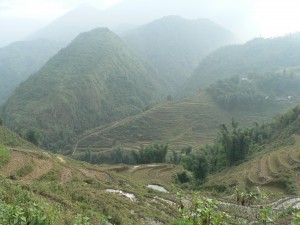 Sa Pa is 1500 metres above sea level and is home to mount Fansipan (Phan Xi Phang), the highest peak in Vietnam at 3143 metres. Hotels are built on the very edge of the valley and offer spectacular views of the area.
Sa Pa is 1500 metres above sea level and is home to mount Fansipan (Phan Xi Phang), the highest peak in Vietnam at 3143 metres. Hotels are built on the very edge of the valley and offer spectacular views of the area.
A tour of Ta Van village at the base of the valley gives a fascinating insight into the lives of the Hill tribe people. From the entry gate, the walking tour takes around four hours. For the less energetic, there is the option to do a one hour walk of the valley which includes a bus tour. At the end of the day, sample the local wine, ‘Dao Mao’ which is made from apples. Tours can be booked at the Sa Pa tourist office, which also offers free Vietnamese lessons for visitors.
Hoa Lu is around 100km from Hanoi and located near the town of Ninh Binh. It was the capital of Vietnam under the Dinh Dynasty which ran from 968 to 980 AD. The ancient citadel covers an area of three square kilometres and the outer ramparts enclose temples, shrines and the king’s court. Two sanctuaries worth visiting are Dinh Tien Hoang and Dai Hanh. A short boat trip away is Bich Dong Grotto in the village of Van Lam, and the Tam Coc Caves and the Xuyen Thuy Grotto.
While there, the Cuc Phong National Park is also worth seeing. The Perfume Pagoda is one of several pagodas and Buddhist shrines built into limestone cliffs in the Huong Tich Mountain and offers stunning views of the area.
Da Nang is Vietnam’s fourth largest city and home to some extremely picturesque sites including the Ngu Hanh Son (Five Element Marble Mountains) which lie close to the sea and have caves and elaborate pagodas. 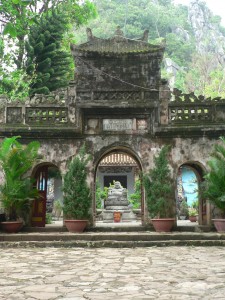
Also in the area is Vietnam Central Beach, which stretches for several kilometres between Monkey Mountain and Marble Mountain. The region is currently undergoing major redevelopment, with many new major resorts being built along the ocean front.
Thirty-two kilometres south-east of Da Nang is Hoi An which was an important international port from the 17th to 19th centuries. It’s a combination of charming heritage streets and riverside setting, markets, Chinese assembly halls and Japanese remnants. Hoi Ann is also the garment district of Vietnam, with a wide selection of expert tailors who can measure and make virtually any outfit in less than 24 hours for a very good price.
For a cultural educational experience, the Red Bridge cooking school offers a one day course in Vietnamese cuisine. It includes tours of the vegetable and fish markets, travel by boat to the school, supervised cooking of a range of authentic dishes with all notes provided.
Outside Hoi An is My Son Holy Land, the capital of the kingdom of Champa from the 5th to 12th centuries. Here you can see the original Cham towers and the 10th century shrine of Bhadresvara that was once the spiritual centre of the Chams. There’s a great view of Champa to be had from the Mountain Church (Nha Tho Nui), which is on top of Buu Chau Hill in the town of Tra Kieu.
A three-hour drive north of Da Nang is the city of Hué, which is widely regarded as the most beautiful city in Vietnam.
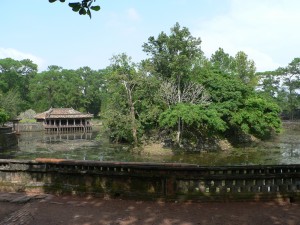 It is home to architectural treasures, including palaces, royal tombs, mausoleums, pagodas and temples and is framed by the Song Huong (Perfume river) as well as being adjacent to a mountain range. The rooftop bar of the Imperial hotel in the centre of town gives 360 degree views of the city.
It is home to architectural treasures, including palaces, royal tombs, mausoleums, pagodas and temples and is framed by the Song Huong (Perfume river) as well as being adjacent to a mountain range. The rooftop bar of the Imperial hotel in the centre of town gives 360 degree views of the city.
Hué was one of Vietnam’s cultural, religious and educational centres and was also the country’s political capital from 1805 to 1945, under the 13 emperors of the Nguyen Dynasty. Hué’s imposing citadel has a perimeter of 10 kilometres and inside is the Forbidden Purple City, reserved for the private life of the emperor, Nam Giao (Temple of Heaven) was once the most important religious site in Vietnam.
The ruins of its huge, moated citadel contains many beautiful historical sites, such as the Nine Holy Cannons, the Imperial Enclosure, the Palace of Supreme Harmony and the Halls of the Mandarins. Tragically, many of the structures were destroyed during the French and Vietnam Wars. After the 1968 bombings, just 14 out of over 100 monuments were left standing. Fortunately, rebuilding began in 1990 through funding from UNESCO and continues today.
Just north-east of Hué is Thuan An beach. From here, visitors can take sampan trips up the Perfume River and sample traditional food and music. Also in the region is the infamous Ho Chi Minh Trail and the remarkable tunnels of Vinh Moc that were used by locals during the wars.
The Hai Van Pass divides North and South Vietnam. Considered the largest frontier post in Vietnam, it is accessed by a 21 kilometre-long road which winds back and forth to a height of 435 metres above sea level. Its name means ’Pass of the Ocean Clouds,’ since the peak of the mountain is in the clouds, while its base is close to the sea. From the top, one can admire Lang Co Beach to the north and Da Nang to the south. There are vast forests to the west and the ocean is to the east.
Dalat, located in the Central Highlands region is renowned for its relaxing, natural ‘green’ environment. A popular tourist destination, it is probably one of Vietnam’s best-known vacation sites, with picturesque French villas from the 1930s dotting the surrounding hillsides. Places of interest include Emperor Bao Dai’s Summer Palace and the colourful food and flower markets.
Nha Trang is on the south central coast of Vietnam, and the turquoise waters of its beach are perfect for swimming. Boat trips are also available to offshore fishing villages, Monkey Island and for diving.
Saigon’s most popular sights include the Reunification Palace, the War Remnants Museum and Notre Dame Cathedral which was built in neo-Romanesque style. The central Ben Tanh Market is the best for souvenir bargains and delicious food stalls. You can also visit Giac Lam Pagoda, the oldest pagoda in the city and the spectacular Chinese-style Emperor of Jade Pagoda. The central Post office has giant wall maps of Saigon and the Mekong Delta regions that date back to 1900.
The beach resort in Vung Tau is 128 kilometres south-east of Saigon and is a popular weekend getaway. It can be reached by a 75-minute hydrofoil trip.
The flat, lusciously green Mekong Delta is the southernmost region of Vietnam and is a two hour drive from Saigon. The landscape here is a vast patchwork of rice paddies and canals. The Cai Rang floating markets are the hub of the Mekong Delta’s fishing and farming trades and tourists are welcome.
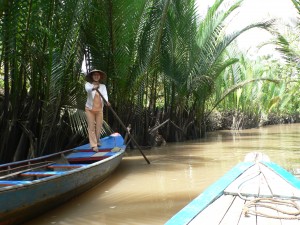 Hiring a sampan boat and tour guide is the perfect way to watch the Mekong come alive. The riverbank is lined with stilted, wooden houses that are built right on the water’s edge.
Hiring a sampan boat and tour guide is the perfect way to watch the Mekong come alive. The riverbank is lined with stilted, wooden houses that are built right on the water’s edge.
Further into the Delta is Can Tho, the biggest city in the Mekong Delta. It has an array of photogenic floating markets nearby, as well as being close to the Cambodian border. Here, you can also find the lively river town of Chau Doc, which offers gorgeous sunset views from the top of Sam Mountain.
Off the far south-west coast of Vietnam is Phu Quoc Island, which has beautiful white beaches and a growing number of resort-style hotels. It is famous in Vietnam for its black pepper and nuoc mam, or fish sauce, as well as its pearl factories. For peace, tranquility and relaxation, it is the perfect holiday destination.
This article first appeared in Asian Paradises Magazine.
